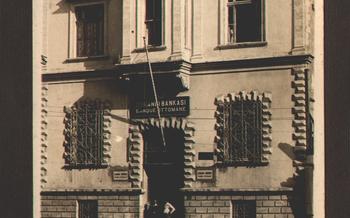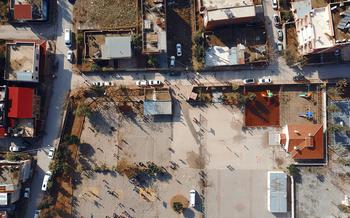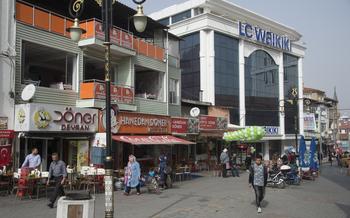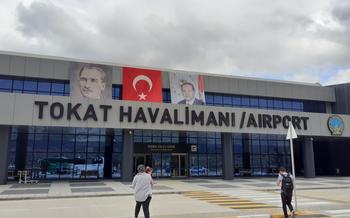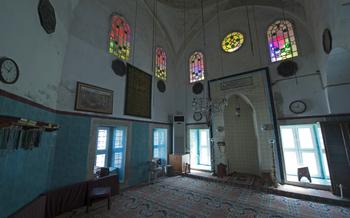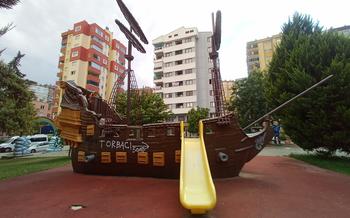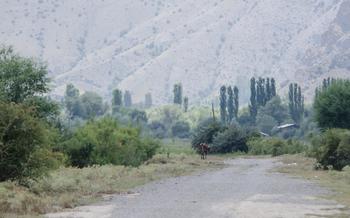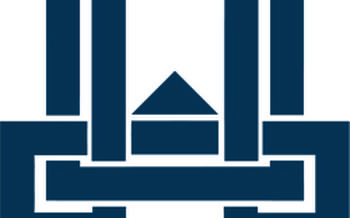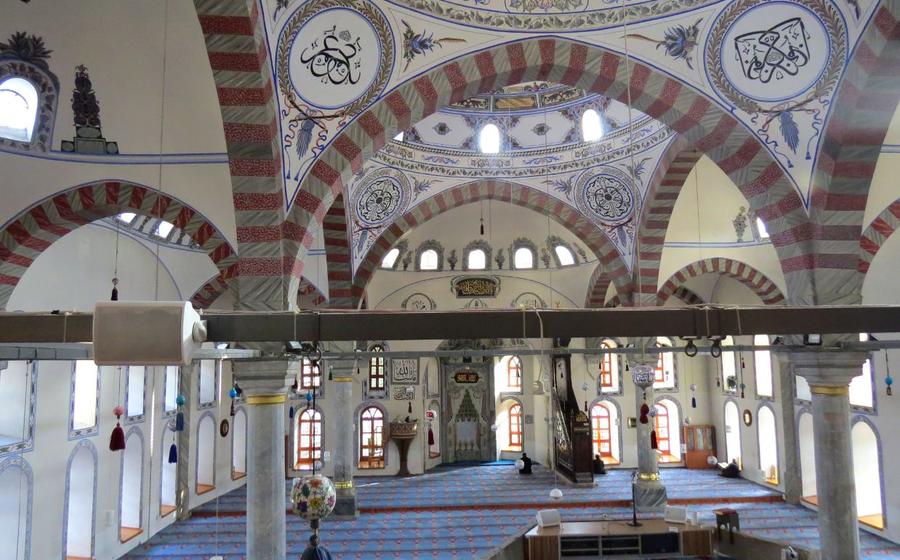
Kütahya Fatih Mosque
- Location and Access
- Exploring the Mosque's Exterior
- Step Inside the Prayer Hall
- Admire the Calligraphy and Tilework
- Experience the Spiritual Atmosphere
- Respectful Etiquette for Visitors
- Nearby Attractions and Activities
- Local Cuisine and Delicacies
- Exploring Kütahya's Rich History
- Kütahya's Vibrant Culture
- Getting Around Kütahya
- Accommodation Options
- Insider Tip: Discover a Hidden Gem
Location and Access
The Kütahya Fatih Mosque is conveniently located in the heart of the city, making it easily accessible by foot or public transportation.
To reach the mosque by public transportation, visitors can take any bus that stops at the Kütahya Merkez Otogar (Central Bus Station). From there, it is a short walk to the mosque.
For those driving, the mosque is situated near several major roads, including the D565 and the D300. There is ample street parking available in the surrounding area.
The mosque is open to visitors daily from 9 am to 5 pm, with the exception of prayer times. Visitors are welcome to enter the mosque and explore its interior, but are asked to be respectful of worshippers and maintain silence while inside.
Exploring the Mosque's Exterior
The exterior of the Kütahya Fatih Mosque is a testament to the architectural prowess of its builders. The spacious courtyard invites visitors into a tranquil oasis, where an ablution fountain stands as a symbol of purification before entering the holy space. Verdant greenery surrounds the courtyard, creating a serene atmosphere that contrasts with the bustling city beyond.
The mosque's four slender minarets rise majestically towards the sky, their intricate designs showcasing the attention to detail that characterizes Islamic architecture. These minarets serve as a call to prayer, their melodious voices echoing throughout the neighborhood at the appointed times.
The mosque's central dome is a sight to behold, its imposing size and elegant shape dominating the skyline. Intricate tilework adorns the dome, creating a mesmerizing visual display that changes with the angle of the sun. The tiles, in vibrant shades of blue, green, and turquoise, form intricate geometric patterns that reflect the mosque's rich cultural heritage.
Step Inside the Prayer Hall
The prayer hall of the Kütahya Fatih Mosque is a sanctuary of peace and devotion, where the faithful gather to connect with the divine. The heart of the hall is the mihrab, a beautifully carved niche in the wall that indicates the direction of Mecca. Intricate geometric patterns and verses from the Quran adorn its surface, creating a mesmerizing focal point for prayer.
To the right of the mihrab stands the minbar, a raised platform from which the imam delivers sermons and leads prayers. Its elegant design and intricate carvings reflect the importance of the spoken word in Islamic tradition. The minbar is a symbol of authority and guidance, inviting the congregation to listen attentively and follow the teachings of the imam.
The floor of the prayer hall is covered in soft, colorful carpets and rugs, adding to the sense of warmth and serenity. These carpets are not merely decorative; they provide a comfortable and clean space for worshippers to prostrate themselves in prayer. The intricate designs and patterns on the carpets reflect the rich artistic heritage of Islamic culture and contribute to the overall ambiance of the hall.
The combination of the mihrab, minbar, and carpets creates a harmonious and uplifting space that fosters a deep sense of connection between worshippers and their Creator. Whether you are a devout Muslim or simply a visitor seeking tranquility, the prayer hall of the Kütahya Fatih Mosque offers a sanctuary for reflection and spiritual renewal.
Admire the Calligraphy and Tilework
The Kütahya Fatih Mosque is adorned with intricate calligraphy and tilework that showcase the artistic and cultural heritage of Turkey. The walls and mihrab are adorned with beautiful calligraphy, demonstrating the skill and artistry of Ottoman calligraphers. Verses from the Quran and other religious texts are elegantly inscribed in various styles, adding to the mosque's spiritual atmosphere.
The mosque's tilework is equally impressive, featuring vibrant colors and intricate geometric patterns. The tiles, which cover the walls, mihrab, and dome, create a mesmerizing visual display that captivates the eyes. The tilework is a testament to the skill and craftsmanship of Turkish artisans, who have a long tradition of creating stunning tilework for mosques and other religious buildings.
The calligraphy and tilework in the Kütahya Fatih Mosque not only enhance its visual appeal but also contribute to its religious and cultural significance. They serve as reminders of the mosque's history, its connection to the Islamic faith, and the rich artistic traditions of Turkey.
Experience the Spiritual Atmosphere
The Kütahya Fatih Mosque is not just an architectural marvel but also a vibrant spiritual center. The mosque's daily prayer times offer visitors a unique opportunity to witness or even participate in the congregational prayers, immersing themselves in the devotion and tranquility that envelop the space.
Beyond the prayers, the mosque exudes a sense of peace and serenity, making it an ideal place for contemplation and reflection. The harmonious blend of natural light filtering through the stained-glass windows and the intricate patterns of the carpets creates an ambiance that invites visitors to find solace and connect with their inner selves.
The mosque also serves as a gathering place for the local Muslim community, fostering a sense of unity and belonging. Visitors can observe the vibrant social interactions that take place in the courtyard and the mosque's various chambers, gaining insights into the community's traditions and customs.
Whether seeking spiritual enlightenment, a moment of tranquility, or a glimpse into the heart of the local culture, the Kütahya Fatih Mosque offers a truly immersive and enriching experience for all visitors.
Respectful Etiquette for Visitors
As a visitor to the Kütahya Fatih Mosque, it is important to be respectful of the local customs and traditions. When entering the mosque, visitors should dress modestly, covering their shoulders and knees. Women may also be required to cover their heads with a headscarf. It is essential to maintain silence and reverence while inside the mosque, as it is a place of worship for Muslims. Photography is allowed in most areas of the mosque, but it is important to seek permission before taking pictures, especially if people are praying. Visitors should also avoid touching or leaning against religious objects or decorations. By following these guidelines, visitors can show respect for the sanctity of the mosque and help preserve its serene atmosphere.
Nearby Attractions and Activities
In addition to the Kütahya Fatih Mosque, there are several other significant landmarks and attractions in the vicinity that are worth exploring. The Ulu Mosque, another impressive historical mosque, is located just a short walk away. Built in the 14th century, the Ulu Mosque showcases intricate Seljuk architecture and is a testament to Kütahya's rich Islamic heritage.
For those interested in delving deeper into the region's history, the Germiyan Museum is a must-visit. This museum houses a collection of artifacts and exhibits that shed light on the Germiyan Beylik, a local Anatolian beylik that ruled Kütahya from the 13th to the 15th century. Visitors can learn about the beylik's history, its contributions to the region, and its cultural legacy.
Another captivating attraction is Kütahya Castle, a historic fortress that stands atop a hill overlooking the city. Built in the 15th century, the castle offers breathtaking panoramic views of Kütahya and the surrounding countryside. Visitors can explore the castle's ramparts, towers, and courtyards, immersing themselves in its rich history and strategic importance.
Local Cuisine and Delicacies
Kütahya is renowned for its pottery tradition, but its culinary delights are equally captivating. Be sure to savor the flavors of "gökçe," a specialty pastry filled with cheese, spinach, or minced meat. Don't miss "höşmerim," a sweet dessert made from thin layers of dough soaked in syrup and topped with clotted cream. Delight your senses with "katmer," a flaky pastry filled with cheese or potatoes, and indulge in the crispy goodness of "simit," a ring-shaped bread encrusted with sesame seeds. Explore the vibrant local markets to discover fresh produce, artisanal cheeses, and traditional Turkish sweets that will tantalize your taste buds.
Exploring Kütahya's Rich History
Kütahya's history is deeply intertwined with the Germiyan Beylik, an independent Anatolian beylik that ruled the region from the 13th to the 15th century. The Germiyan Beylik left a lasting legacy on Kütahya's culture, architecture, and identity. Visitors interested in exploring this rich history can visit several historical sites in the city.
The Germiyan Hamamı, or Germiyan Bathhouse, is a well-preserved example of Seljuk architecture and a testament to the beylik's patronage of the arts. The Dervişoğlu Konağı, or Dervişoğlu Mansion, is another architectural gem from the Germiyan period, showcasing the beylik's wealth and power. These historical sites offer a glimpse into Kütahya's past and provide a deeper understanding of the city's cultural heritage.
Kütahya's Vibrant Culture
Kütahya is renowned for its thriving handicraft industry, reflecting the city's rich cultural heritage. Pottery, in particular, holds a special place in Kütahya's identity. The city has been a center of pottery production for centuries, and its skilled artisans continue to create exquisite pieces of art using traditional techniques. Visitors can find a wide variety of pottery items in Kütahya, from decorative plates and vases to intricate tiles and figurines.
Tile-making is another important handicraft in Kütahya. The city's tiles are known for their vibrant colors and intricate geometric patterns. They are often used to decorate mosques, palaces, and other buildings, adding a touch of elegance and artistry to the urban landscape.
Carpet weaving is also a significant part of Kütahya's cultural heritage. The city's carpets are hand-woven using traditional methods and feature intricate designs and rich colors. These carpets are not only beautiful but also durable, making them a popular choice for both homes and businesses.
In addition to these traditional crafts, Kütahya is also home to a variety of festivals and events that showcase the city's vibrant culture. The Kütahya Pottery Festival, held annually, is a major event that attracts visitors from all over the country. The festival features exhibitions of pottery from local artisans, live demonstrations, and workshops where visitors can learn about the pottery-making process. Other festivals and events in Kütahya celebrate music, dance, and other aspects of the city's rich cultural heritage.
Getting Around Kütahya
Kütahya's public transportation system offers a convenient and affordable way to explore the city. Buses are the primary mode of public transport, connecting different neighborhoods and landmarks. Visitors can purchase a transportation card, known as a "KentKart," which provides discounted fares and can be used on all public buses. Taxis are also readily available, offering a more personalized travel experience. However, it's important to agree on a fare before starting your journey to avoid any misunderstandings.
For those who prefer the freedom and flexibility of their own vehicle, car rental is an option. Several car rental agencies operate in Kütahya, offering a range of vehicles to suit different needs and budgets. However, visitors should be aware that driving in Turkey can be challenging, especially in busy urban areas. It's advisable to exercise caution and familiarize yourself with local traffic regulations before hitting the road.
Accommodation Options
Kütahya offers a range of accommodation options to suit different budgets and preferences. For budget-conscious travelers, there are several guesthouses and hostels that provide basic but comfortable lodgings. These guesthouses often have a friendly and welcoming atmosphere, allowing visitors to interact with locals and fellow travelers.
For those seeking a more comfortable stay, there are several mid-range hotels that offer modern amenities and सुविधाएं. These hotels typically have air-conditioning, private bathrooms, and Wi-Fi, ensuring a pleasant and convenient stay.
For a truly immersive experience, consider staying in a local guesthouse or homestay. This is an excellent opportunity to connect with the local community, learn about Turkish culture and traditions, and enjoy traditional Turkish hospitality. Many guesthouses and homestays offer delicious homemade meals, allowing visitors to sample local cuisine and interact with their hosts.
Insider Tip: Discover a Hidden Gem
Kütahya Museum: A Treasure Trove of Local History and Culture
For those seeking a deeper dive into Kütahya's rich history and vibrant culture, a visit to the Kütahya Museum is a must. Located in the heart of the city, this hidden gem houses a fascinating collection of artifacts that tell the story of Kütahya's past.
Explore the museum's diverse exhibits, showcasing pottery, carpets, traditional costumes, and other relics that provide a glimpse into the region's unique heritage. Learn about the Germiyan Beylik, the local Anatolian beylik that ruled Kütahya for over two centuries, and admire the exquisite craftsmanship of Kütahya's renowned pottery tradition.
The Kütahya Museum is a treasure trove of local history and culture, offering visitors an immersive journey through the ages. Don't miss the opportunity to discover this hidden gem and gain a deeper appreciation for Kütahya's rich tapestry of traditions and customs.

